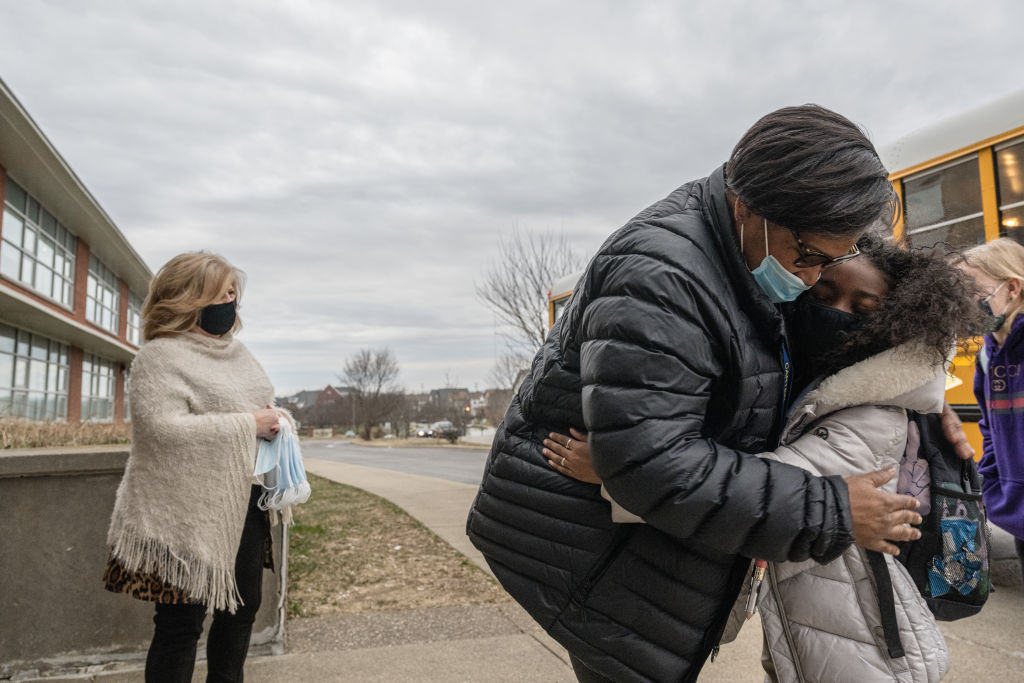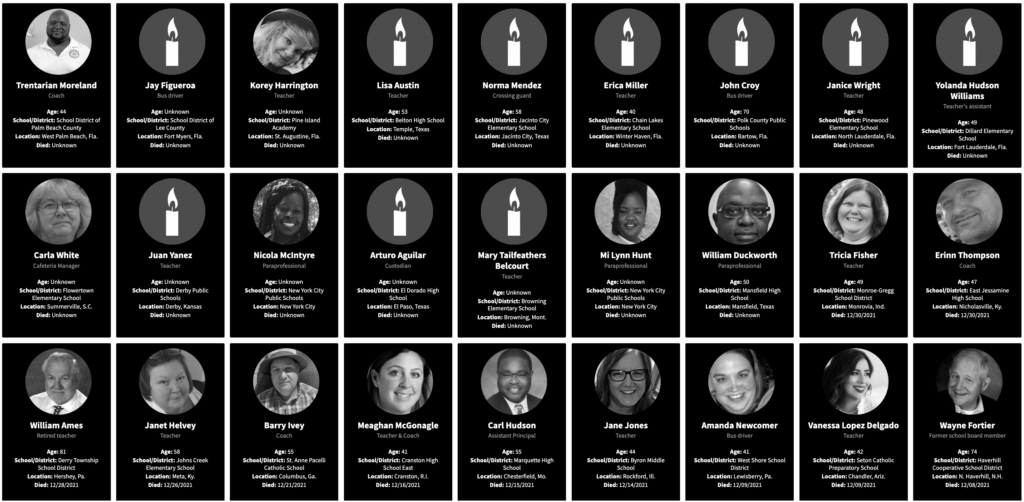
As COVID exacerbated inequities in U.S. society, many Americans witnessed gender, class and racial inequality in a new and existential way—especially in the distinct overlap between populations of “essential workers” and Black and brown people. These workers, who often make the lowest salaries, were expected nonetheless to remain on the job. Black and brown people experienced disproportionate infection, hospitalization and death.
Early on in the pandemic, when little was known about the virus and no vaccine yet existed to thwart it, some “essential workers”—those in healthcare—received applause daily for their heroic efforts to staunch the bleeding. But one group, made up primarily of women, was on the receiving end of bitter acrimony and blame for allegedly aggravating the problems caused by the pandemic: teachers.
Teachers were among the groups of workers who were able to stay home, at least in many school systems, for a period of the pandemic—especially those represented by a union. But before they were able to work from home, teachers suffered from staggering levels of COVID infection. On April 3, 2020, Education Week began an online memorial to acknowledge the deaths of educators, janitors and other school personnel.

The vast majority of schools moved to remote education—the Census Bureau estimates that approximately 93 percent of students had some form of online instruction—but the transition was bumpy at best, not the least because schools had to choose between two bad options: continue in person, risking the health of both students and teachers, or send everyone home to do their best.
As schools shut down, parents were confronted with starkly varied problems in coping with having children at home. Those who could work remotely had to take on organizing virtual schooling while also learning how to work remotely themselves. For others, the “essential workers,” the main challenge was figuring out childcare while they were delivering groceries, filling online shopping orders, developing a vaccine and driving ambulances—with the added concern of bringing illness home with them.
The challenging circumstances facing parents spurred a significant backlash against teachers, who were blamed for failing to do what other essential workers were doing and stay on the job, no matter the personal cost. (Perhaps these parents somehow forgot that teachers, too, have children; indeed almost half had children at home themselves while schools were operating virtually.)
Teachers were blamed for failing to do what other essential workers were doing and stay on the job, no matter the personal cost.
Working conditions for teachers, bad before the pandemic, only got worse. Even before COVID-19, most public school teachers struggled to gather adequate supplies for their classrooms each year. The financial burden of this often falls on teachers, who “regularly spend their own money on purchasing school supplies for their classroom or for a fellow teacher’s classroom, including items like pencils, crayons, glue sticks, books and classroom furniture,” according to the Brookings Institution, a nonprofit public policy organization.
When the pandemic hit, this burden increased in both size and necessity. Eighty-six percent of teachers say they had to buy their own PPE for their classrooms, either for their own use or that of their students.
The conditions of school infrastructure are also problematic. As of 2014, “half of all public schools in the United States need[ed] at least one major facility repair,” according to Phi Delta Kappan, an education publication. And in 2017 the American Society of Civil Engineers (ASCE) gave the public K-12 infrastructure a D+ quality grade on their Infrastructure Report Card.
Finally, to compound the difficult working conditions, teachers also are often not paid a truly livable wage. “Two-thirds of teachers reported having had to work a second job in order to make ends meet” and 31 percent of those said they are currently doing so—even in 2020, during a pandemic.
Even before the catalyst of the pandemic, 8 percent of teachers dropped out of teaching each year. That number has only gotten worse since the beginning of the pandemic, with teachers leaving the profession in far greater numbers across the country than before. Teaching online and managing students’ participation remotely, combined with dealing with parents’ aggravation and anger, made teaching more stressful than it was before COVID, according to almost 85 percent of teachers. Now, over 50 percent of teachers say they are “somewhat” or “very likely” to abandon the profession within the next two years, compared to 34 percent in 2019.
With all that’s expected of educators, teachers have had to become more and more professionalized. Close to 60 percent of them had a graduate degree, such as a master’s or doctorate, as of the 2017–18 school year. Compare that to 47 percent less than 20 years earlier. This, despite low pay and poor working conditions.
Still, teachers remain the Rodney Dangerfields of professionals: They “don’t get no respect.” Why is that? For starters, Americans don’t think teachers work nearly as many hours as the educators in fact put in, underestimating teaching hours by almost a full school day less than they work. This lack of respect is mirrored by the teachers’ views of their own status—in fact, teachers rate their status lower than the general public does, perhaps due in part to equating low pay, degraded facilities and lack of resources with lack of respect. And it’s hard to blame them.
In the face of this major challenge to public education and our faith in it, Americans—and especially women—must confront whether we are willing to see teaching as a profession worthy of respect and decent pay, thereby improving teacher retention and school stability. Or will we just accept that privileged Americans will simply opt out and put their kids in private schools? For progressives, feminists and advocates for democracy, what happens to our belief in the egalitarian virtues of public education, the role it plays in leveling the demographic playing field, and the importance of elevating the status of a profession long dominated by women if we fail to support teachers?
A special thanks to Mason Grow for her invaluable assistance with the article.
U.S. democracy is at a dangerous inflection point—from the demise of abortion rights, to a lack of pay equity and parental leave, to skyrocketing maternal mortality, and attacks on trans health. Left unchecked, these crises will lead to wider gaps in political participation and representation. For 50 years, Ms. has been forging feminist journalism—reporting, rebelling and truth-telling from the front-lines, championing the Equal Rights Amendment, and centering the stories of those most impacted. With all that’s at stake for equality, we are redoubling our commitment for the next 50 years. In turn, we need your help, Support Ms. today with a donation—any amount that is meaningful to you. For as little as $5 each month, you’ll receive the print magazine along with our e-newsletters, action alerts, and invitations to Ms. Studios events and podcasts. We are grateful for your loyalty and ferocity.
Up next:





